Fine and brandy
THE charming, medieval town of Cognac is where an Irishman called Richard Hennessy started his distillery in 1765.

"COGNAC is a brandy but not all brandies are Cognac," our guide Marc Boissonnet tells us on several occasions during an afternoon drive around the Cognac region of France.
Boissonnet’s offical job is as an ambassador for the Cognac house Hennessy, the world’s biggest producer of the amber drink. But, as it turns out, he’s much more. “Do you like Cognac?” he asks, driving us through the charming, medieval town with its narrow, cobbled streets and elegant, historic buildings. “I couldn’t live anywhere else, I get depressed when I have to leave here and go to Paris,” he says, before we have time to answer.
It’s easy to see why someone wouldn’t want to leave this place. It is one of the most beautiful parts of western France. Cognac is situated on the River Charente between the towns of Angouleme and Saintes, about 100km north of Bordeaux. King Francois I declared that the slow-moving Charente was the loveliest river in his kingdom.
Our final stop on the tour is the recently completed Hennessy museum on the left bank of the river. The contemporary building was constructed only of materials that are used in the production of Cognac: limestone, copper, wood and glass.
As we enter the museum, I hear another giude say to a group of visitors: “Cognac is a brandy but not all brandies are Cognac.” The difference between the two drinks is that Cognac must be made in Cognac, whereas brandy can be made anywhere.
But it doesn’t end there. Cognac must be made from certain grapes and of these Saint Emilion is the most widely used variety. About 6200 vineyards make up the region and harvesting starts in October. After the grapes are pressed, the juice is left to ferment for two or three weeks. Then the wine is distilled twice and at the end of the process the colourless spirit, or eau de vie, is about 70 per cent alcohol. It is then transferred to oak barrels to age for a minimum of two years.
The age of a Cognac is determined solely by the number of years it has spent in wooden casks. During the ageing process, Cognac loses between 3 per cent and 4 per cent of its volume every year. It’s the alcohol that evaporates and as the spirit ages its aromas become concentrated, its colour darker. At about 10 years of age Cognac reaches its maturity and should be about 40 per cent alcohol.
Most of the world’s Cognac is produced by four companies: Courvoisier, Martell, Remy Martin and Hennessy, yet
there are more than 200 producers in Cognac.
The assembly process is where the brandy really begins to come to life. Making Cognac is a bit like chemistry, whereby different vintages are blended to produce the final product. But, unlike chemistry, there are few written rules or formulas. The cellar masters don’t use measuring instruments; they rely instead on their judgement and senses of smell and taste. It’s often said that the true value of Cognac houses is in the skill and know-how of the cellar masters.
Hennessy, which was founded by Richard Hennessy – an Irishman – in 1765, is estimated to be responsible for more than 40 per cent of the world’s Cognac and in recent years has made a push into a younger demographic. Some of that has happened by chance, the brand being referenced in rap songs by artists such as Kanye West,
P Diddy and 50 Cent, who gave it the nickname “Henny”. But marketing has also played a part. Hennessy has introduced products such as Pure White, designed to be drunk either on ice or as long drink, further enhancing the brand’s appeal to younger customers.



